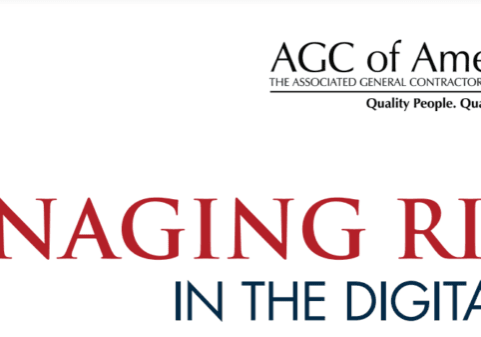Articles | Publications | Popular Blog Posts
Privacy Infographic: Blueprint for GDPR & CCPA Compliance, 2022.
Infographic describing our best-practices approach involving data mapping, risk assessment, and gap analysis. We team with IT specialists to guide organizations through their privacy compliance journey. Whatever your current privacy law compliance, you can safely start here with a completely confidential consultation. Download our free one-page infographic, GDPR / CCPA Privacy Compliance Blueprint.
CCPA / CCPR Privacy White Paper: CALIFORNIA DREAMIN' - A Blueprint for Compliance, 2022
A review of the actual and potential impact of large states like California and New York, adopting GDPR-like legislation. GDPR principles such as Privacy by Design (PbD), are becoming the law in the U.S. "Foreign" laws like California's CCPA are actually enforceable against organizations here in the Northeast. Fortunately, it is possible to build compliance solutions that can meet both current existing and anticipated requirements. The white paper outlines a series of actionable best practices that can be adopted to nearly any organizational structure. Read about our approach to compliance in California Dreamin’ – A Blueprint for CCPA/CPRA Compliance.
Data Protection & Privacy Article: RISKY BUSINESS - Familiar Technologies that Require a Data Protection Impact Statement (DPIA) under the GDPR, 2021
Some everyday technologies are considered so inherently risky to privacy rights that organizations using them are required to analyze and report on the risks, at least in the EU so far. The risky technology list is long and surprising: AI, Covid-19 contact tracing, online exam proctoring, IoT, genetic data, social media, etc. Any organization handling Personal Information (PI or PII or PHI) using these technologies, and not already GDPR compliant, must prepare comply with similar U.S. laws.. Learn which technologies are considered inherently risky in RISKY BUSINESS: Technologies Requiring a Data Protection Impact Assessment (DPIA) under the GDPR.
GDPR Privacy White Paper: The Top 10 Things to Know About GDPR, 2018.
A concise description of the European Union General Data Protection Regulation (GDPR) as applied to U.S. based organizations. GDPR establishes and enforces a set of seven data protection principles designed to protect the privacy rights of EU citizens. While it may not directly impact U.S. enterprises not doing business in the EU, any organization with a website that may reach EU citizens should review its procedures. Learn what is important about GDPR by reading and downloading our white paper, The Top 10 Things to Know About GDPR.
Information Governance White Paper: C-Level Guide to Covering Your Information Assets, 2015.
How the revised FRCP 37(e) sanctions rule adopted in December 2015 provide a game-changing “green light” to organizations wanting to automate the deletion / destruction of unneeded legacy and other data in a legally defensible way. Contact us for a privileged and confidential consultation or evaluation. Read more here...
Legally Defensible Data Remediation (Blog Post) Read here...
Information & Data Governance: Why Boards and C-Level Executives Are Sailing in Dangerous Waters (Blog Post) Read here...
Information Governance: A Principled Approach (Blog Post) Read here...
Legal Hold 101: Data Retention and Destruction (Blog Post) Read here...
The Top 10 Things to Know About the EPA RRP (Lead Paint) Rule Read more...
Legal Aspects of Managing Construction Projects in Massachusetts (© 2009, 120 pg.) A legal and practical guide to risk management in construction. Focused on Massachusetts law with free mechanic's lien forms. Also contains useful information on AIA and ConsensusDocs contracts applicable to any state. Read Chapter 5 excerpt on best practices for construction recordkeeping and documenting a claim.
The Top 10 Things to Know About Electronic Discovery (eDiscovery) Free Download Top 10 Things to Know About eDiscovery
The Top 10 Reasons to Have a Document Retention Policy Read more...
The Top 10 Things to Know About Information Security Programs (rev. September 2009) Read more... (note - compliance deadline for 201 CMR 17.00 began March 1, 2010)
Unintended Consequences of the Adoption of New Building Technologies: Galvanic Corrosion and Pressure Treated Wood Read full article...
2002 Connecticut Construction Law Section Review: Bonds Read more...
Blogs
Design and construction law topics from the perspective of an attorney with a background in the construction industry
Technology nearly always outpaces the development of the law. This blog looks at a variety impactful developments in tech.
Why the Outside General Counsel Model Is More Relevant Than Ever in 2025
The 2025 State of the Corporate Law Department Report from Thomson Reuters reveals a legal landscape in flux—one where general counsel (GCs) are redefining their roles, rethinking value, and embracing new models of legal service delivery. Among the most resilient and adaptive models is the Outside General Counsel (OGC) approach, which continues to gain traction across industries. The Value Imperative “Value” is the dominant theme of the 2025 report. It was mentioned three times more often in interviews than in the previous year [1]. GCs are no longer just legal advisors—they’re strategic enablers, risk managers, and operational partners. The report identifies four pillars of value: Effectiveness: Delivering high-quality legal advice aligned with business strategy. Efficiency: Serving the business cost-effectively, often through technology and AI. Protection: Managing risk and regulatory compliance. Enablement: Helping the business grow through strategic legal support [1]. “GCs must ensure that they add value through the quality of their legal advice and interactions with stakeholders.” — Thomson Reuters [1] This framework aligns perfectly with the OGC model, which offers continuous, strategic legal support without the overhead of full-time in-house counsel. Cost Control and the Decline of the Billable Hour GCs are under pressure to do more with …
Drone Operations in Construction: Navigating Federal Aviation Administration Requirements and Liability Exposure
Unmanned aircraft systems have become indispensable tools for construction project management, but rapid adoption has introduced regulatory compliance obligations and liability risks that require careful legal consideration. Drone technology provides construction companies with unprecedented capabilities for site surveying, progress monitoring, and safety inspections that were previously costly and time-consuming. However, the construction industry’s rapid adoption of drone technology has created new efficiencies alongside regulatory compliance obligations and liability risks that demand careful legal attention. Federal Aviation Administration Regulatory Framework Federal Aviation Administration regulations govern all commercial drone operations, including construction-related activities. The Part 107 rule establishes operational limitations that construction companies must observe, including daylight-only operations, visual line-of-sight requirements, and altitude restrictions. Construction sites often present complex airspace challenges, particularly in urban environments where temporary flight restrictions may apply or where operations near airports require additional coordination. The regulatory framework requires remote pilot certification for anyone operating drones commercially, including construction applications. Construction companies must ensure that personnel conducting drone operations possess appropriate Federal Aviation Administration certifications and understand applicable limitations. Violations can result in significant civil penalties and potential criminal liability. Professional Liability Considerations Professional liability considerations extend beyond regulatory compliance to encompass the accuracy and application of drone-collected …
Building Information Modeling and Professional Liability: Who Owns the Risk When Digital Models Fail?
The construction industry’s widespread adoption of Building Information Modeling has transformed project delivery, but this digital revolution brings complex liability questions that traditional construction contracts were never designed to address. Building Information Modeling technology creates a shared digital environment where architects, engineers, contractors, and subcontractors contribute to and rely upon a single comprehensive model. This collaborative approach generates significant benefits, including reduced conflicts, improved coordination, and enhanced project visualization. However, the very nature of shared digital modeling creates potential liability traps that project participants often fail to recognize until disputes arise. The Fundamental Challenge of Shared Responsibility The primary legal challenge lies in determining responsibility when BIM-related errors lead to construction defects, schedule delays, or cost overruns. Traditional professional liability concepts assume clear boundaries between design and construction responsibilities. BIM technology blurs these lines by enabling real-time model updates throughout the project lifecycle. Consider this scenario: when a structural engineer modifies the digital model to reflect field conditions, and that modification creates conflicts with mechanical systems, who bears responsibility for the resulting problems? The answer depends largely on contract language that frequently fails to address these scenarios adequately. Key Legal Consideration Standard form agreements developed before widespread BIM adoption contain …
Internet of Things Sensors and Data Ownership: Some Legal Implications of Smart Construction Sites
Smart sensors now monitor everything from concrete curing temperatures to worker safety conditions, generating vast amounts of real-time data that inform critical project decisions. However, this technological advancement raises complex legal questions about data ownership, privacy protection, and liability for sensor-based decisions that the construction industry is only beginning to address. Data Ownership and Access Rights Construction IoT implementations typically involve multiple stakeholders contributing to and accessing shared data streams. Environmental sensors provided by concrete suppliers, safety monitoring systems installed by general contractors, and progress tracking devices deployed by project owners create interconnected data ecosystems. Determining ownership rights and usage permissions for this collectively generated information requires careful contractual planning that most standard construction agreements do not address. Data ownership disputes can arise when sensor information becomes crucial to dispute resolution or change order documentation. IoT Use Raises Many Critical Questions If temperature sensors indicate that concrete curing conditions required schedule adjustments, who controls access to the underlying data? When safety sensors detect conditions that influence project decisions, what rights do various stakeholders have to access and use this information? Privacy Regulation Compliance Privacy regulations add significant complexity to construction IoT deployments. Worker monitoring sensors may collect personal information subject …
Modular Construction in the Northeast and Northwest: Who Owns the Risk?
Modular building being lowered by crane onto foundation
Goldfish in a Concrete Aquarium
Most of my pre-law school building experience was in New England. Besides the ever changing weather, differing subsurface site conditions presented a variety of challenges. Ledge is commonplace but very hard to predict whether a nearby outcropping would interfere with excavation. Water well depth was typically difficult to predict even by drillers with local experience. And, most challenging was dealing with groundwater, especially flooded basements. Even with perc test holes, the distance from the septic field to the foundation increased the odds that the groundwater level in the excavation was different, or upon digging a spring was found. In Seattle, as a construction lawyer in the 1990s, I was called on frequently by owners to help diagnose and remedy wet or flooded foundations. One memorable project was a dream house being constructed by a tech millionaire. Soon after the foundation and then the slab were poured, the basement filled up with over a foot of water. The framers and follow on trades referred to it as a “pond” and started to buy and release gold fish. Funny, not funny to the owner. This particular project had multiple points of failure, mostly within the control of the contractor. Like actor Jim …
California Dreamin’ – A Blueprint for CCPA/CPRA Compliance
New U.S. Privacy Laws Follow GDPR Trend With the approval of the CPRA citizen’s initiative (Consumer Privacy Reform Act amending the CCPA – Proposition 24) and the introduction of new privacy legislation in New York and elsewhere all moving toward a U.S. equivalent of GDPR, it is time to face the fact that U.S. privacy compliance obligations are here to stay. When GDPR enforcement began in 2018, many U.S. businesses that were not operating in the EU considered it something that was happening “over there.” Enforcement of the California CCPA (California Consumer Privacy Act) began in January 2020. Now, the hope of avoiding strict privacy compliance obligations “over here” is now only a dream. The CPRA amended and strengthened the CCPA, moving it closer to the protections afforded to EU citizens, and post-Brexit, to UK citizens. (Proposition 24 approved November 2020; Effective 1/1/23.) it is time to face the fact that U.S. privacy compliance obligations are here to stay There are privacy bills pending before the New York Assembly that like CCPA/CPRA adopt many of the key privacy principles staked out by the GDPR: Consent, Privacy by Design, Data Minimization, Lawful Purpose, and Information Security. In addition, both the California …
RISKY BUSINESS: Technologies Requiring a Data Protection Impact Assessment (DPIA) under the GDPR
Under the European Union GDPR privacy compliance obligations, Data Protection Impact Assessments (DPIA) are mandatory for data processing “likely to result in a high risk to the rights and freedoms of data subjects.” Failure to conduct such a risk assessment is a breach of the GDPR that is subject to significant fines. Whether an organization is required to comply with the GDPR is beyond the scope of this article but if your organization processes any of the following types of “risky” Personal Data of EU or UK citizens listed in the table below, now is the time to find out. Personal Data is broadly defined as any information relating to an identified or identifiable natural person, in particular by reference to an identifier such as a name, an identification number, location data, an online identifier or to one or more factors specific to the physical, physiological, genetic, mental, economic, cultural or social identity of that natural person. How can an organization determine whether to incur the expense of conducting a DPIA? According to Article 35(3) of the GDPR, there are three types of processing that always require a DPIA: 1) systematic profiling with significant effects; 2) large scale use of …
Solar Winds Supply Chain Hack Wins Password Contest
Privacy and cybersecurity compliance issues are inextricably linked. In one sense, they are peas in a pod. A security breach can leak all sorts of information assets, from useless server logs to trade secrets to sensitive personally identifiable information, or PII. At the heart of many privacy compliance obligations is the recognition of a duty to make “reasonable” efforts to protect PII through technical and organizational means. Such balancing tests are necessarily a key aspect of enterprise risk management. The massive SolarWinds supply chain hack is a case in point. On January 12, 2021, security research company CrowdStrike reported discovery of a 3rd strain of malware named SUNSPOT that was deployed in September 2019 – that is 15 months before the first discovery of the hack by cybersecurity company FireEye on December 8, 2020. There are important questions to be answered about the scope and intent of the hack. Was it a massive penetration testing dry run? Can infected IT infrastructure be fully cleaned without burning it to the ground and rebuilding? Was it espionage on steroids or an act of war? How many more shoes will drop? News reports of the SolarWinds hack often speculate whether important PII was …
US-EU Privacy Shield Perforated – GDPR after Schrems II
On July 16, 2020, the European Court of Justice (ECJ – the European Union’s high court) invalidated the EU-US Privacy Shield Framework as a potential mechanism for meeting the GDPR’s cross-border personal data transfer restrictions. Effective immediately, U.S. companies that process EU “personal data” can no longer rely on registration under the Privacy Shield and must establish an alternative legal basis for any continued EU-US transfers. Previously, cross-border transfers to the US were permitted under three mechanisms: 1) the Privacy Shield (http://privacyshield.gov), 2) Standard Contractual Clauses (SCC), and 3) Binding Corporate Rules (BCR). The Privacy Shield was originally developed in response to a 2005 ECJ decision invalidating the “US-EU Safe Harbor Framework,” an earlier agreement to permit U.S. companies to process EU personal data in a way that protected EU privacy rights. Privacy Shield, administered by the Federal Trade Commission, allowed companies self-certify compliance and was generally considered a workable GDPR solution for U.S. companies that processed (touched) EU personal data. Impacts The decision has made waves not just because it declares that any cross-border transfer of personal data under the Privacy Shield is illegal but because it has immediate effect. According to a FAQ issued by the European Data …
Death Trap Buildings
On July 9, 2020, the World Health Organization (WHO) bowed to pressure from scientists to concede that the novel coronavirus (SARS-CoV-2) could cause infection via aerosols. (See https://bit.ly/39EHerk.) Aerosols are simply small droplets (generally described as under 5 microns) containing the virus that can linger in the air for hours. The author of the linked New York Times opinion article, engineering professor Linsey Marr, writes that a 5 micron droplet takes about a half-hour to drop from the mouth of an average height adult to the floor – longer if there are air currents. Link to article, https://nyti.ms/3ggetDM. This is not rocket science, even the Aztecs knew that smallpox was airborne. The implications of this fact are enormous, for the legal liability of design professionals responsible for maintaining healthy buildings, for employers responsible for employee safety under the general duty clause of OSHA, and for people with a statistically higher risk of poor health outcomes if infected. ASHRAE has already released a document beginning to address airborne transmission (https://bit.ly/2PccVit) but as Professor Marr’s article describes in the NYT, scientific data on this risk vector is in its early development. Employers and school administrators with responsibility for reopening decisions must now …
Pyrrhotite Contaminated Concrete – A Call for Collaboration
In Biblical fashion, more than 34,000 residential foundations in Connecticut and Massachusetts were built on sand between 1983 and 2016. Not literally, but many if not most residential concrete foundations containing pyrrhotite aggregate from Becker’s Quarry in Willington, CT and mixed by JJ Mottes Concrete in Stafford Springs, CT will need to be repaired or replaced eventually. Those that contain pyrrhotite and have not (yet) shown evidence of failure will remain suspect and likely impact the value of the real estate. This article focuses on the single-family residential sector but the problem may be wider. Connecticut DOT asserted that pyrrhotite concrete has not impacted its structures. However, there is visual evidence that some commercial and multi-family residential structures are showing telltale signs of pyrrhotite deterioration. What is known is that thousands of pyrrhotite foundations are crumbling in a slow-motion disaster. The cost of correction currently ranges from $150,000 to $350,000, for lifting and fully replacing foundations. The economic impact on the region is immense. Connecticut officials have already identified approximately 50 towns affected by pyrrhotite foundations. Only about 700 buildings have been officially reported to date in Connecticut. However, Governor Malloy estimates that over 34,000 homes might be affected. Massachusetts …
Constructuring
Associated General Contractors (AGC) and FMI recently published a survey of contractors’ perceptions of risk together with an analysis of factors expected to drive change in the U.S. engineering & construction (E&C) industry in the coming years. See Managing Risk in the Digital Age. The survey (completed late 2017 and published in 2018) yielded in four key findings: The “people factor” remains one of the biggest risks for E&C firms in today’s business environment. Industry stakeholders expect to see more change in the built environment within the next five years than there has been in the last 50 years. Most survey respondents are innovating “around the edges” and adopting technology in a piecemeal fashion (or not at all) but not fundamentally transforming their business approaches. For years, contractors have tackled risk by purchasing insurance programs and managing claims. Today that is no longer enough. The survey notes that business is strong and is expected to continue well into 2019. Despite the current positive activity, E&C industry leaders are concerned with a variety of risk factors including: labor shortages (especially skilled trades and field supervisors but including managers), the decline in the quality of design documents, and the accelerating pace of …
California Consumer Privacy Act – GDPR Principles Arrive in the U.S.
In the wake of the Cambridge Analytica scandal, restrictions on monetization of personal information (aka PI or PII) are coming to California in 2020. The California legislature unanimously passed a historic bill to adopt many of the core privacy principles of the EU General Data Protection Initiative (GDPR) for California consumers. The bill was fast-tracked into law in order to avoid the likely passage of a more rigorous ballot initiative in the November election. The key difference between the ballot initiative and the adopted law is that the legislative version can be more easily amended to avoid unintended consequences. Indeed, the industry lobbying has already begun. A statement by the Internet Association immediately criticized the legislation: It is critical going forward that policymakers work to correct the inevitable, negative policy and compliance ramifications this last-minute deal will create for California’s consumers and businesses alike. The significance of this new law on U.S. businesses will be far reaching. The state of California is now recognized as the world’s 5th largest economy, surpassing the United Kingdom. California’s 40 million “consumers” have just gained privacy rights quite similar to those recently afforded to EU citizens by the General Data Protection Regulation (GDPR). Unlike …
Eureka – Privacy Discovered in California?
The California Consumer Privacy Act of 2018 is a ballot initiative that has gained more than enough signatures to appear on the November 6, 2018 general election ballot. If approved by the voters, the Act will greatly expand privacy rights in California. It will apply to larger companies that do business in California as well as entities that collect substantial amounts of Personal Information from California residents. California has in the past led the US in various trends and regulations, good and bad. Freeways, Beach Boys, hippies, hipsters, car culture, bikers, early Burning Man, the music industry, and Hollywood helped define US culture. Well-known regulations and restrictions on air quality such as CARB (CA Air Resources Board), on “chemicals known to the state to cause cancer or reproductive toxicity” such as Proposition 65, and on offshore drilling have been very influential. Facebook, Google, Apple, AirBnB, Tesla, and yes, Theranos are all California companies. Beauty is in the eye of the beholder In 1976, a wealthy acquaintance in the Bel Air hills invited me for drinks to survey the skyline overlooking Los Angeles at dusk from his poolside perch. Like the successful Mr. McGuire in The Graduate urging Ben to steer his career towards the …
Reality Bites – Caught “Lead Handed” on TV
Do TV contractors poison their real world customers? According to an EPA press release dated June 5, 2018: “The U.S. Environmental Protection Agency (EPA) and Magnolia Waco Properties, LLC, which does business as Magnolia Homes, have reached a settlement to resolve alleged violations of the Toxic Substances Control Act (TSCA) Lead Renovation, Repair and Painting Rule (RRP Rule), related to home renovations conducted without adequate lead paint protections as depicted on the television program Fixer Upper. Under the terms of the settlement, Magnolia will take steps to ensure compliance with lead-based paint regulations in future renovation projects, address lead-based paint hazards at high-risk homes in Waco, Texas, and educate the public to lead-based paint hazards and appropriate renovation procedures.” Allegedly, according to a November 29, 2017 administrative complaint, Chip and Joanna Gaines, stars of HGTV’s “Fixer Upper” and owners of Magnolia Waco Properties, LLC (d/b/a Magnolia Homes), “did not comply with all of the requirements of the RRP Rule in renovations it performed in 33 properties in the Waco, Texas.“ Getting caught “lead handed” on national TV is sort of the opposite of demonstrating competence in the building industry. Who would have thought that the RRP applied on television or …
GDPR Privacy by Default – Will the US Senate Follow Europe?
On May 25th, Senators Edward J. Markey (D-Mass.), Dick Durbin (D-Ill.), Richard Blumenthal (D-Conn.), and Bernie Sanders (I-Vt.) introduced a Senate resolution calling for U.S. companies and institutions covered by the European Union’s (EU) new privacy law, the General Data Protection Regulation (GDPR), to provide Americans with privacy protections included in the European law. The 5 page Resolution summarizes the GDPR as requiring: that data processors have a legal basis for processing the data of users; and that opt-in, freely given, specific, informed, and unambiguous consent from users is a primary legal basis. The Resolution is not a bill and has not yet been debated or adopted. However, it was symbolically introduced on the very same day that European GDPR became law. Many US enterprises are impacted by the new EU law, because they control or process the personal data of people in the EU. Some US companies have announced full compliance with the GDPR for all people worldwide. Others have geofenced and blocked EU data subjects. Others, like the Washington Post, have erected a supposedly compliant paywall to provide GDPR-compliant and ad-free access to the EU countries. The Markey Resolution “encourages entities” already covered by the impact of the …
The GDPR is Coming
Does GDPR Apply in the US? Yes. GDPR (European Union General Data Protection Regulation) is a comprehensive new law protecting the data privacy of EU citizens. GDPR takes effect on May 25, 2018. It consists of 99 articles and will have sweeping impact on U.S. enterprises. It requires that all personal data be handled according to the GDPR Data Protection Principles. These includes the famous “right to be forgotten,” as well as transparency, data portability, breach notification, information security, etc. If you have a public facing website that collects user data and operates in EU countries, it is not too late to get advice. Watch this space as we roll out solutions for enterprises that are not ready.
The Top 10 Things to Know About GDPR
The GDPR protects “personal data” of EU citizens. So, if you are only doing business outside the European Union then you don’t have to consider it at all, right? Think again. What about any business with a website?
EPA Still Says Get the Lead Out
Through back channels only at the time of this writing, EPA announced the results of its “Section 610” review of the lead safe rules (RRP). One of the interesting findings is that since the RRP rules were first issued, the science behind lead contamination has changed. In the announcement of the EPA Office of Pollution Prevention and Toxics dated April 2018, the EPA recognizes that lead is even more toxic than previously understood. On first reading of the 67-page announcement, it appears that this fact is significant in EPA’s reasoning behind keeping the rule intact and not re-instituting the old opt-out waiver. The conclusion is that danger still exists, that the overall economic costs of lead poisoning outweigh the costs of compliance, and finally that the issue of high false positive lead test kits is not sufficient to weaken the lead protection. [Copy of EPA Section 610 Review here or see pdf at end of article] The review considered fifteen public comments related to the 610 Review, as well as providing a discretionary response to another twenty comments received during prior comment periods on the accuracy of test kits. The comments and EPA’s responses were in the following categories: lead test …
Risk Management – How to Avoid the Construction Wheel of Misfortune
Risk management is everywhere. The principles, definitions, and plans involving risk management can be applied to almost any industry or endeavor. Depending on the industry, the sources of risk and the consequences of a particular risk, the approach to risk management will vary. Some risk management is mandatory. For instance, the EPA requires facilities that use extremely hazardous substances to submit a risk management plan (RMP) every five years to be in compliance with Sec. 112(r) of the 1990 Clean Air Act Amendments. On the national level, the Department of Homeland Security developed a National Infrastructure Protection Plan outlining, “how government and private sector participants in the critical infrastructure community work together to manage risks and achieve security and resilience outcomes.” Some risk management plans are recommended by government agencies as industry standards. The US DOT Federal Highway Administration published a guidebook, Risk Assessment and Allocation for Highway Construction Management, concluding that, “(t)he business case for including risk assessment and allocation as a standard project management component of major capital projects is unambiguous: The ability to better understand potential risks and how to manage them yields benefits far in excess of the costs of adopting risk management practices.” CalTrans has …
Green Light for Defensible Data Remediation
In December 2015, the electronic discovery provisions of the Federal Rules of Civil Procedure (FRCP) were amended to substantially expand the Safe Harbor against sanctions for destruction of electronic data. In my November 2015 white paper, C-Level Guide to Covering Your Information Governance Assets, I predicted that the amended rules signaled a pivot away from one of the main sources of eDiscovery uncertainty – the inconsistent imposition of severe sanctions for the loss of electronically stored information (ESI) relevant to dispute resolution. The prediction holds. The prior Safe Harbor under the 2006 FRCP provided modest protections against sanctions where ESI was lost due to routine and automatic deletion. Because of the inconsistent standards previously applied by courts around the country, organizations fearful of doomsday sanctions would over-preserve. The new discovery rules greatly expand this protection. A cursory review of sanctions cases decided under the new rules in influential U.S. District Courts indicates that the Federal bench is successfully applying the new rules as the Rules Advisory Committee intended – limiting judicial discretion to impose case-killing sanctions to situations where a party intentionally deprives its opponent of documents covered by a “legal hold.” An excerpt from a Northern District of California …
Information Governance Challenges in the Life Sciences, and Financial Services Industries
While many of the high-level principles of Information Governance (IG) and the technologies supporting their implementation are almost universally applicable, each industry sector presents different challenges – one-size solution does not fit all. For example, unregulated privately held technology start-ups that are experiencing rapid growth may not have any retention / destruction policies in place; they will expand their IT storage until they crash into a big event, such as litigation, an IPO, or a merger. At that point they might require a top to bottom reconstruction – akin to an emergency room visit after a car crash. Other organizations already function within the constraints of a regulatory regime such as life sciences or financial services. Especially in publicly traded companies, regulated industries are further along the continuum in almost all of the metrics associated with IG principles such as: existence of a RIM program; adoption of a retention schedule; legal hold procedures; and protection of sensitive information. Unlike the emergency room metaphor above, the relative maturity of IG initiatives in these organizations requires more of a performance coach than an emergency room doctor to improve their well-being. Organizations also differ greatly in the need for dispersal of their information …
Legally Defensible Data Remediation
A document retention policy is in reality a document destruction policy. Therefore, a key reason for an organization to adopt a document retention policy is to establish a program for the deletion/destruction of information that is not required for business, regulatory and other needs. This reality is made necessary by the fact that digital information is growing at an unprecedented rate and that much of it is contained in “unstructured” storage such as email, SharePoint and shared network drives. Data hoarding not only increases direct information technology costs but it presents other substantial risks and costs to an organization ranging from discovery of “smoking gun” documents during investigation, litigation or audit; to reputational damage from information security breaches (hacking). Document retention/destruction policies have long been recognized as a good business practice. Inherent in the practice is the notion that information has a life cycle and that there are valid reasons to protect that information from competitors, thieves, snoops and even government investigators. In the context of an appeal of an obstruction of justice conviction against Arthur Andersen LLP, this practice was blessed by the U.S. Supreme Court. Chief Justice William Rehnquist delivered the opinion of the Court: ‘Document Retention Policies,’ …
Legal Hold 101 – Data Retention and Destruction
Every gambler knows That the secret to survivin’ Is knowin’ what to throw away And knowin’ what to keep ‘Cause every hand’s a winner And every hand’s a loser And the best that you can hope for is to die In your sleep The Gambler lyrics © Sony/ATV Music Publishing LLC Some of the more frequent questions asked of eDiscovery attorneys when teaming with IT professionals on archiving and other retention policy projects, relate to the timing, scope and especially the release of legal holds. Misconceptions about “Legal Hold” abound, many of them (unfortunately) coming from litigation attorneys stuck in the paper document past or those who do not understand data systems architecture. One common source of over-broad Legal Hold retention is the misapprehension of the risk of severe judicial sanctions for the destruction (aka spoliation) of evidence. Too many attorneys take what they consider to be the safe route and continue to advise enterprises to keep too much for too long. As Kenny Rogers’ Grammy award-winning song reminds us, risk can cut both ways. Not only does an overbroad legal hold increase the cost of maintenance and infrastructure, it increases the cost of legal review of held documents, and …
Other Documents
Table of contents for hosted documents, infographics, etc.















